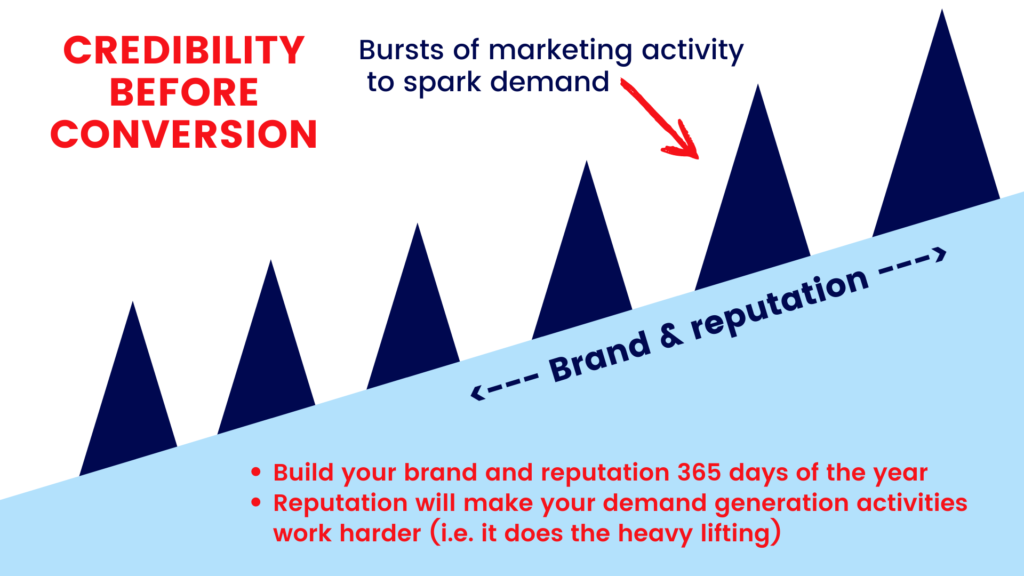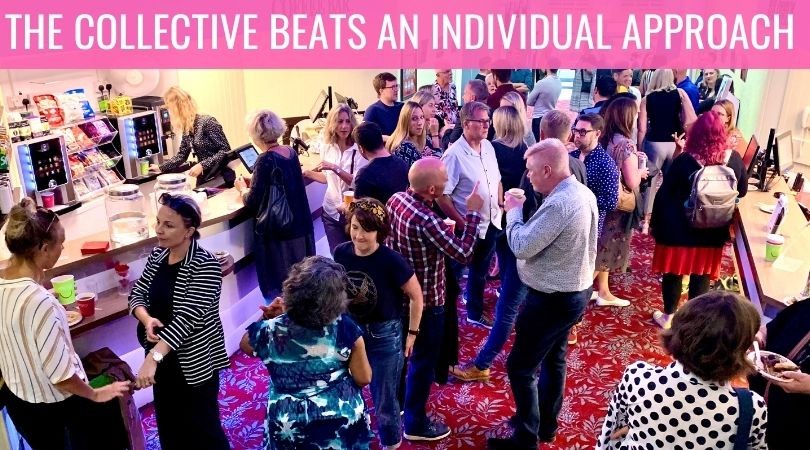
I often chuckle to myself when I see digital marketing ‘gurus’ diss (organic) social media because, they claim, you can’t make sales using the medium.
And they’re right, sort of. You can’t. Not directly anyway.
It’s not impossible, of course, but it is difficult. The exception is if you sell shiny, visually-appealing products that lend themselves to impulse buying, then social (Instagram, Pinterest especially) can be very powerful. THINK: fashion apparel, jewellery and accessories, knick-knacks for the home etc.
But when you’re selling personal and professional services, digital products, software-as-a-service, etc – where the path to purchase can be a bit longer and more considered – then yes, it can be damn hard work to squeeze a direct sale out of organic social media.
Some pundits, such as myself, would say that getting the tills ringing is not the best use of social media. Others, however, are adamant that social needs to pay its way by generating sales.
So this then begs the question: Why bother with social media at all?
It’s a fair question, and one that needs to be addressed with a few factors in mind: what are your goals, and what’s your overarching philosophy, or your thinking, when it comes to social media?
Depending on your circumstances, perhaps it’s time to reframe the role social media plays in your marketing communications mix?
We’re all on the social treadmill to varying degrees; sometimes it’s worthwhile sitting back and reminding ourselves what are the strengths of social media that we can leverage for the benefit of our business.
If your aim is to use social media merely as a channel through which to sell, I think you’ll be disappointed in its effectiveness in this regard. Please bear in mind, I’m talking organic here; paid social (advertising via social media) has a critical role to play, both in building awareness and making sales, but it’s not the focus of this article.
If you feel you’ve drifted away from why you started using social media in the first place and are wondering if it’s all worth it, may I suggest it’s time to go back to basics and reacquaint yourself with how social media works today, and why it can be a powerful lever for your business.
Before we get into it, a bit of perspective: the ideas shared in this article are off the back of my philosophy when it comes to PR and marketing communications:
- I believe entrepreneurs and marketers should put equal time and effort into strategically building a business that’s known, respected and trusted, front of mind with their target audience, and talked about in a positive way in the marketplace. Brand versus demand: credibility before conversion. These are often act as forerunners to commercial outcomes.
- The demand generation aspect of marketing is critical, obviously, but works way more effectively off the back of a strong brand and reputation. Too many businesses have got it arse-about: they incessantly lead with the pitch, which can end up costing a lot of time, money and frustration if they’re not known, trusted, front of mind or talked about in the first place. Put another way: you can choose to interrupt people with a pitch they’re not interested in, or you can communicate respectfully with an audience that knows and trusts your brand, understands what your business is all about, and is receptive to your message. Which is preferable, do you think?
- Think two sides of the same coin: build your brand and reputation ongoing – and punctuate with bursts of promotional and lead gen activity (see graphic below).

Okay, with that out of the way, let’s get back to how we can tap into the strengths of social media for the benefit of our business.
When it comes to social media, I like looking at it through the lens of:
PRESENCE + VALUE + CONNECTION = HEAT
Let’s break these down.
Presence —
Social media provides businesses and professional individuals with an amazing opportunity to stay on people’s radar in a respectful way.
Presence is all about fronting up on a consistent basis: not just ‘dialling it in’ i.e. scheduling posts from afar but never getting into the social trenches to engage with your followers and others using the channel.
And posting randomly every few weeks and expecting some sort of miracle to occur on social media, well, that won’t contribute a heck of a lot to your presence either.
Building a presence on social media – with passion, purpose and strategic intent – requires work and commitment ongoing. Which leads us to our next point: delivering value.
Value —
The concept of value on social media is pretty subjective and can mean different things to different people. Here are some thought-starters:
- Providing useful tips, hints and how-to’s around a particular topic e.g. Julian Mather
- Being provocative, challenging people with your ideas e.g. Greg Savage
- Delivering useful insights around an issue confronting your profession or industry e.g. Anne Miles
- Inspiring people with human stories, experiments undertaken and lessons learned e.g. Ian Whitworth
- Publicly shining the light on others in your network e.g. Mark Masters
- Promoting other people’s content, businesses, causes and events e.g. Venessa Paech, Helen Blunden
- Connecting like-minded people with one another e.g. Heath Evans, Steve Vallas
- Taking people behind the scenes of your business or organisation (or professional life) e.g. Michelle Fotheringham, Joyce Ong
- Sharing cool stuff: links, photos, videos, interesting podcasts etc e.g. Carolyn Hyams/Aquent
- Answering people’s questions and calls for help, if and when you’re able to (not directly related to your business) e.g. John Espirian
- Delivering timely customer service (related directly to your business) – more relevant for bigger companies with sizeable customer numbers: to see best practice in action, check out Buffer’s Twitter account.
Oh, in case you were wondering, it’s not about doing more stuff, it’s about being intentional with what you do on social media, and doing it in a way that’s genuine and human.
(The above examples are largely sourced from LinkedIn and Twitter – the two main social channels I use, but equally, similar examples can be found on other channels: keep an eye out for them!)
Connection —
If sharing content on social media is the ‘media’ part of the equation, then building connection with people through consistent and genuine engagement is the ‘social’ part.
This is the not-so-secret sauce of social media. It’s how social media ignited the attention of the masses in the early days before brands and marketers took over and made it all about them.
But there’s been a bit of a swing back.Build connection with enough people and bring them all together and you’ll start building community, or what I like to call your ‘digital neighbourhood’. Mark Masters does this well with You Are The Media, an initiative that effectively straddles the line between online and offline community (pic below).

Individuals are always going to do this better than branded channels per se, so it’s important to get your people out there on the socials to engage with the public. This is especially so for the owner (and leaders) of a business or organisation.
Hopefully, all this effort will lead to:
Heat —
Generating ‘social heat’ is my way of saying that your brand is attracting attention for all the right reasons. People start taking notice of you, and it’s not just brand awareness either: it’s deeper recognition for what it is you do, and what you stand for professionally, or as a business.
The result of this can go in numerous directions: people will be more likely to share your content, tell their friends about you, recommend your business to others, and potentially reach out and engage with you, particularly in the case of professional individuals and thought leaders.
More good stuff can happen too: people visit your website, watch your videos, read your blog, listen to your podcast, and maybe even sign up to your email newsletter.
Oh, and when it comes time to pitch your wares through advertising or straight call-to-action via promotional posts – hopefully more people take notice and are receptive to your message, whether it’s directly relevant to them, or they’re happy to share with others in their network.
Why? Because they already know, like, trust and respect you: your brand is top of mind and being talked about in a positive way in the marketplace: these are forerunners to commercial success.
#HappyDays



Leave a Reply